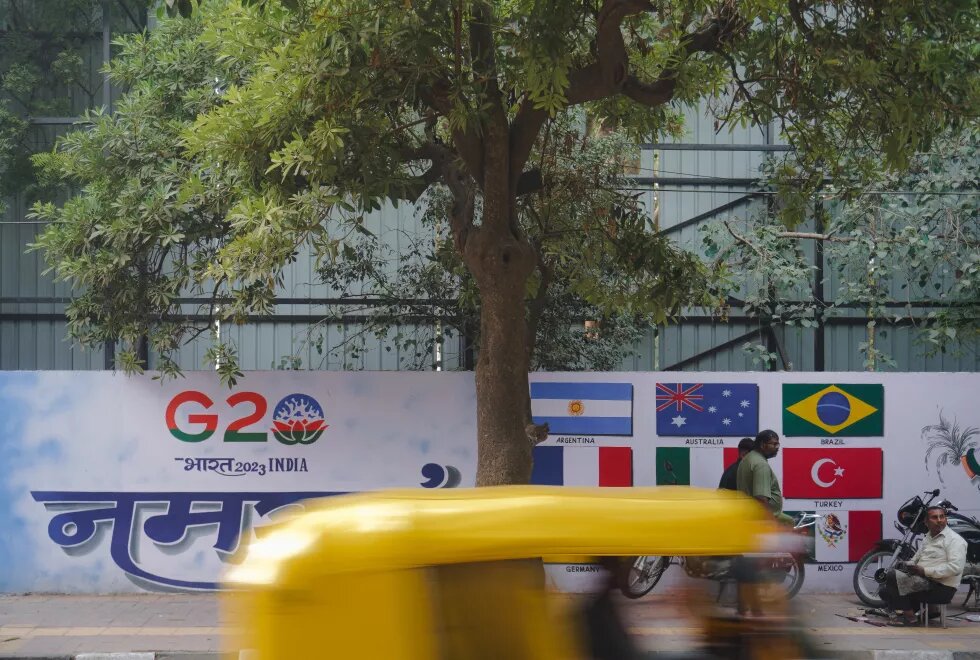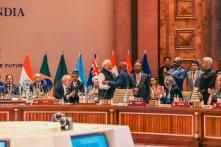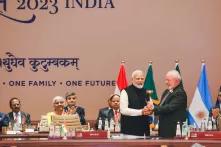
The 18th G20 Leaders’ Summit, under India’s Presidency, concluded with the adoption of the New Delhi Declaration. In the backdrop of the war in Ukraine and a “new cold war” between the US and China, there was much uncertainty about the possibility of a consensus among the G20 leaders. The joint communique has been interpreted as a diplomatic triumph for India, courtesy of its “omni-alignment” foreign policy, as the leaders of the “premier forum for international economic cooperation” came on the same page to keep the G20 relevant. However, the question remains: What did G20 consensually declare and to what extent the decisions address the pressing issues people and the planet are facing?
A Presidency amidst a polycrisis
India became the chair of G20 at a time when the world was witnessing a polycrisis, i.e. “interlocking and simultaneous crises of an environmental, geopolitical and economic nature.” First, global debt has reached a record high at $307 trillion in 2023 that, according to the IMF estimates, will force at least 100 countries to cut down public spending on health, education and social protection in order to repay debts. Second, high inflation and ‘brutal’ rise in food and energy prices, particularly in 2022, has led to a situation that the World Bank has described as the “largest commodity shock” since the 1970s. Slowdown in growth, due to the impact of the pandemic and Ukraine war on global economy, has led to stagflation and rise in interest rates by the US Federal Reserve and other central banks, which is going to hinder economic recovery, mainly in the emerging and developing economies, in the coming years. Third, there is a sharp rise in global inequality in the post-pandemic years, evidenced by the top 1 per cent seizing nearly two-third of the $42 trillion in newly created wealth. Finally, the climate crisis is showing signs of a catastrophic future as the world is facing more extreme weather events and unprecedented ocean heating. Calling for concrete action to address the alarming consequences of climate change, UN Secretary General António Guterres stated in July 2023, “The era of global warming has ended; the era of global boiling has arrived…the level of fossil fuel profits and climate inaction is unacceptable… Leaders must lead.”
A missed opportunity
Given this context, India’s Presidency was indeed challenging, but it also provided the G20 chair an opportunity to lead from the front and champion the concerns of the Global South in particular like debt cancellation, more financial support for climate action, bridging inequalities, ensure sustainable growth and decolonisation of the international financial architecture. In the run up to the summit, for instance, civil society organisations (CSOs) wrote to the Indian Prime Minister, the IMF and the World Bank to make the consultations on global debt distress representative, transparent and under traditional institutional settings involving UN bodies. Similarly, more than 200 eminent economists wrote to the UN Secretary General and the World Bank chief demanding concrete measures to address income and wealth gaps. At the domestic level, CSOs and grassroots organisations held events such as the ‘We20’ and ‘People’s20’ to assimilate, articulate and assert the peoples’ issues, and demand action from the decision makers to achieve a just and equitable future by putting people over profits. It was expected that India as the chair would consider the people’s demands seriously, leverage its position to advance those concerns as a powerful representative of the developing world, and resist the unbridled dominance of the rich G7 countries over international economic governance.
Unfortunately, India missed this opportunity. For instance, as economist Jayati Ghosh pointed out, there “is really nothing in terms of anything to deliver for the rest of the world, or even for their own countries’ people.” Instead of giving voice to people’s concerns, India’s Presidency was turned into an advertisement blitz as the ruling government in India aimed to bolster the image of Prime Minister Narendra Modi at the international stage as well as to impress the voters before the national election in 2024. Moreover, while people’s initiatives were suppressed, G20 engagement groups such as Youth20 or Civil20 were chaired by individuals close to the ruling regime, which led to the projection of a one-sided and “majoritarian view” of India.
A statement sans solutions
Despite being considered a diplomatic success, the New Delhi Declaration is the lengthiest ever statement with no concrete agreement or actionable point in it. The statement has been perceived as “uninspiring and underwhelming,” “empty promises,” “disappointing,” and “a compromise.” To appreciate these critical responses, it is important to grasp what the joint declaration actually offered for the people and the planet.
Firstly, the declaration is marked by weak language and commitments. It failed to address the pressing issues faced on a global level like economic inequalities, food insecurity, inflation, ecological destruction, systematic erosion of the rights of workers and vulnerable communities, geopolitical conflicts, and democratic backsliding in member countries. On the war in Ukraine, for instance, the declaration highlights the “human suffering and negative added impacts” on the global economy without mentioning Russia. This has been interpreted as a clear win for Russia and China. The mild language was, however, accepted by the G7 countries to keep the G20 relevant, maintain close ties with emerging market economies and uphold the dominance of the Bretton Woods institutions over the global financial system. For the West, a weak declaration was a better option than no consensus as it could not let India’s Presidency fail because of its politico-economic interests in the Indo-Pacific region. The non-committal language is also evidenced in the repeated use of phrases such as “we call on,” “we commit,” “we recognise,” and “we reaffirm” without mentioning any substantive, timeline oriented targets on any issue.
Secondly, as observers noted, the proclamations made in the declaration, on pressing issues like Sustainable Development Goals (SDGs), global debt, climate action and just energy transition, and trade, turned out to be mere lip service because of their non-binding nature. According to political scientist John Kirton, the G20 leaders promised “to keep doing what they have already committed to do or to explore options, endorse or support others' work or commission studies.” For instance, the progress on achieving the 17 SDGs has only been around 12 per cent globally and reaffirming this older commitment, without paying any serious attention to address poverty, inequality and new ways of development finance, rings hollow. Similarly, on the issue of addressing debt distress, the declaration reiterated the already failed strategies such as the Debt Service Suspension Initiative and the Common Framework for Debt Treatments. These measures have repeatedly failed to address the debt crisis (here, here, here and here). On the issue of finding a solution to bilateral debt of low-income countries, New Delhi failed to take on board emerging sovereign creditors like China. Further, no agreement could be reached to phase out coal and no new timeline was created to address the worsening climate crisis. Although the leaders committed to triple renewable energy capacity by 2030 and the need for $4 trillion a year for green energy transition, observers have questioned these announcements for the lack of concrete pathways. Further, the declaration endorsed the Summers-Singh report on re-capitalisation of multilateral development banks (MDBs) with riders, but it failed to address the much-needed reform of governance of global MDBs like the World Bank group. Not surprisingly, the text also renewed G20’s commitment to preserve financial stability and long-term fiscal sustainability, achieve price stability, promote open, rules-based trade and combat protectionism, even though the geopolitical tensions (such as between Beijing and Washington) or security-driven trade pacts (such as the Indo-Pacific Economic Framework for Prosperity) is fragmenting the tenets of multilateral trading system.
Thirdly, the noteworthy takeaways from the New Delhi Summit are: (a) launch of the Global Biofuels Alliance (GBA), (b) plan to build a trade route viz. the India-Middle East-Europe (IMEE) Economic Corridor, a counter-project to China’s Belt and Road Initiative, and (c) push for a global digital public infrastructure (DPI). Without a time-bound action plan, the GBA remains meaningless. Moreover, as critics have pointed out, the GBA triggers the risk of cultivable land being grabbed for the production of ethanol. Similarly, the implementation plan of the IMEE corridor is still unprepared. The proposal of this corridor was declined by Turkey, which opted for its own Iraq Development Road Project. With the ongoing war in Gaza and changing power relations in the Middle East, one needs to wait and watch the future of this project. India’s proposal of a global Digital Public Infrastructure was also refused by countries where the use of credit cards is dominant.
Finally, the inclusion of the African Union (AU) as a permanent member of the forum, perhaps the most significant outcome of India’s Presidency, was a much-awaited decision. While the African nations can now, theoretically speaking, use this seat to better negotiate with the developed world in terms of their concerns such as debt and climate action, the move also benefits the developed countries to get access to critical minerals required to meet the energy transition challenges worldwide. This decision admittedly catalyses India’s aspiration to become the voice of the Global South. However, such an aspiration is not unchallenged as countries like Indonesia, Brazil and South Africa have reportedly played a crucial role alongside India in building the consensus on the final declaration. Moreover, the declaration, as one observer noted, did not point a finger at the US Federal Reserve’s unilateral high-interest rate policy, which has amplified the debt vulnerabilities of impoverished nations by approximately $800 billion. These crucial silences reveal that the G20 continues to remain an elite club, irrespective of who chairs it. India’s Presidency was no exception. Nonetheless, the question remains: Can Brazil’s Presidency of G20 next year change this perception by seriously addressing its agenda of tackling inequality, acting on the climate crisis, and promoting unity in a divided world?


